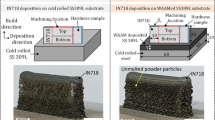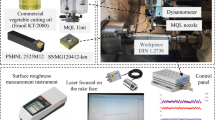Abstract
The resolution of features machined with abrasive slurry jets is dependent on the diameter of the erosion footprint on the workpiece and on the stability of the jet. Previous work has shown that the footprint size decreases, but the jet oscillation increases, with increasing polymer concentration. The present study investigated the effect of nozzle design on jet stability in abrasive slurry-jet micro-machining of glass using slurries with dissolved polymers. A variety of transparent acrylic nozzles were made with different geometries and a 180-μm sapphire orifice to study the oscillation of jets of water mixed with high molecular-weight polyethylene oxide. Fluorescent streak photography of the flows within the nozzles confirmed the presence of unstable vortices that can lead to jet oscillation. However, the dependence of these vortices on nozzle geometry and PEO concentration was unclear. Jet oscillation was then measured photographically and found to increase nonlinearly with polymer concentration for all nozzle geometries. These results were used to design and manufacture a new steel nozzle with a 30° tapered entrance region which reduced jet oscillation. Micro-channels were then machined in glass plates using a range of polymer slurries containing aluminium oxide particles. The polymer concentration that produced the best combination of a relatively small footprint while simultaneously minimizing the jet oscillation amplitude resulted in channels that were 11% narrower than reference channels machined with a pure water slurry and a standard nozzle.
Similar content being viewed by others
References
Molitoris M, Piteľ J, Hošovský A, Tóthová M, Židek K (2016) A review of research on water jet with slurry injection. Procedia Eng 149:333–339. https://doi.org/10.1016/j.proeng.2016.06.675
Liu H (2010) Waterjet technology for machining fine features pertaining to micromachining. J Manuf Process 12:8–18. https://doi.org/10.1016/j.jmapro.2010.01.002
Nguyen T, Shanmugam D, Wang J (2008) Effect of liquid properties on the stability of an abrasive waterjet. Int J Mach Tools Manuf 48:1138–1147
Kowsari K, James DF, Papini M, Spelt JK (2014) The effects of dilute polymer solution elasticity and viscosity on abrasive slurry jet micro-machining of glass. Wear 309:112–119. https://doi.org/10.1016/j.wear.2013.11.011
Barnes HA, Hutton JF, Walters K (1993) An introduction to rheology. Vol. 3, 1st edn. Elsevier B.V, Amsterdam
Holtmeyer MD, Chatterji J (1980) Study of oil soluble polymers as drag reducers. Polym Eng Sci 20:473–477
Hoyt JW, Taylor JJ, Runge CD (1974) The structure of jets of water and polymer solution in air. J Fluid Mech 63:635–640. https://doi.org/10.1017/S0022112074002102
Boger DV, Williams HL (1972) Predicting melt flow instability from a criterion based on the behavior of polymer solutions. Polym Eng Sci 12:309–314
Nguyen H, Boger DV (1979) The kinematics and stability of die entry flows. J Nonnewton Fluid Mech 5:353–368. https://doi.org/10.1016/0377-0257(79)85023-5.
Boger DV, Crochet MJ, Keiller RA (1992) On viscoelastic flows through abrupt contractions. J Nonnewton Fluid Mech 44:267–279. https://doi.org/10.1016/0377-0257(92)80053-Z
Evans RE, Walters K (1986) Flow characteristics associated with abrupt changes in geometry in the case of highly elastic liquids. J Nonnewton Fluid Mech 20:11–29. https://doi.org/10.1016/0377-0257(86)80013-1
Boger DV, Walters K (1993) Rheological phenomena in focus. 1st ed. Elsevier Science Publishers B.V, Amsterdam, pp 35–72
Chiba K, Nakamura K (1997) Instabilities in a circular entry flow of dilute polymer solutions. J Nonnewton Fluid Mech 73:67–80. https://doi.org/10.1016/S0377-0257(97)00036-0
Nouraei H, Kowsari K, Spelt JK, Papini M (2014) Surface evolution models for abrasive slurry jet micro-machining of channels and holes in glass. Wear 309:65–73. https://doi.org/10.1016/j.wear.2013.11.003
Kowsari K, Nouraei H, James DF, Spelt JK, Papini M (2014) Abrasive slurry jet micro-machining of holes in brittle and ductile materials. J Mater Process Technol 214:1909–1920. https://doi.org/10.1016/j.jmatprotec.2014.04.008
Anna SL, McKinley GH (2001) Elasto-capillary thinning and breakup of model elastic liquids. J Rheol (N Y N Y) 45:115–138. https://doi.org/10.1122/1.1332389.
McKinley GH (2005) Visco-elasto-capillary thinning and break-up of complex fluids. http://hdl.handle.net/1721.1/18085
ASTM C702 / C702M-18, Standard practice for reducing samples of aggregate to testing size. https://doi.org/10.1520/C0702_C0702M-18
Dutta NN, Pangarkar VG (1995) Critical impeller speed for solid suspension in multi-impeller three phase agitated contactors. Can J Chem Eng 73:273–283
Booth C (1963) The mechanical degradation of polymers. Polymer (Guildf) 4:471–478. https://doi.org/10.1016/0032-3861(63)90060-0.
Acknowledgements
The work was supported by the Natural Sciences and Engineering Research Council of Canada.
Author information
Authors and Affiliations
Corresponding authors
Rights and permissions
About this article
Cite this article
van Wijk, E., James, D.F., Papini, M. et al. Micro-machining with abrasive slurry-jets: effects of dissolved polymer concentration and nozzle design. Int J Adv Manuf Technol 102, 317–331 (2019). https://doi.org/10.1007/s00170-018-3173-5
Received:
Accepted:
Published:
Issue Date:
DOI: https://doi.org/10.1007/s00170-018-3173-5




